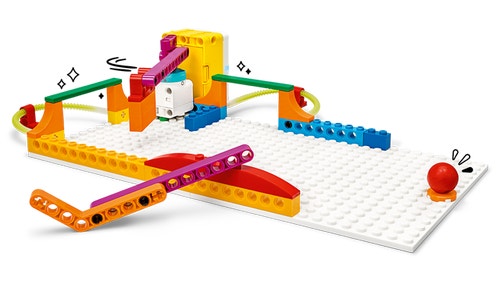SPIKE™ Essential
High Stick Hockey
See how many goals you can score in Maria’s hockey game simulator!
30-45 min.
Beginner
Years 3-5

Prepare
- Review the High Stick Hockey lesson in the LEGO® Education SPIKE™ App.
- Consider the abilities and backgrounds of all your pupils. Differentiate the lesson to make it accessible to everyone. Please refer to the Differentiation section below for suggestions on how to do this.
- If time permits, plan and facilitate the maths extension. Please refer to the Extension section below for further information.
Engage
(Whole Class, 5 Minutes)
- Facilitate a quick discussion about ways of finding evidence that energy can be transferred from one place to another.
- Talk with your pupils about what happens when a ball is thrown against a wall and ricochets off.
- Ask questions like these: What happens to the ball when it ricochets off the side of the wall? What happens to the wall? What happens to the ball?
- Introduce your pupils to the story’s main characters and the first challenge: seeing how many goals they can score while playing the hockey game.
- Distribute a brick set and a device to each group.
Explore
(Small Groups, 30 Minutes)
- Have your pupils use the LEGO® Education SPIKE™ App to guide them through their first challenge:
- Create and test the program to see how many goals they can score in three goes.
- Have your pupils iterate and test their models to complete the next two challenges in the app:
- Modify the program to make the hockey game more fun.
- Upgrade the hockey game to make it harder to score.
- You can find coding and building help in the Tips section below.
Explain
(Whole Class, 5 Minutes)
- Gather your pupils together to reflect on their completed challenges.
- Ask questions like these: How did you program the hockey game to score a goal? How did the energy being transferred from the hockey stick to the ball impact the ball's motion? How was the energy of the ball impacted when it collided with the wall?
Elaborate
(Whole Class, 5 Minutes)
- Prompt your pupils to discuss and reflect on the importance of observing and understanding how energy transfers.
- Ask questions like these: How can you use your knowledge of energy transfer to help score more points? In what other games do you see energy being transferred from one place to another?
- Have your pupils tidy up their workstations.
Evaluate
(Ongoing Throughout the Lesson)
- Ask guiding questions to encourage your pupils to ‘think aloud’ and explain their thought processes and reasoning in the decisions they’ve made while building and programming their models.
Observation Checklist
- Measure your pupils’ proficiency in understanding and describing how energy can be transferred.
- Establish a scale that suits your needs. For example:
- Requires additional support
- Can work independently
- Can teach others
Self-Assessment
Have each pupil choose the brick that they feel best represents their performance.
- Yellow: I think that I can describe how energy can be transferred.
- Blue: I can describe how energy can be transferred.
- Green: I can describe how energy can be transferred, and I can also help a friend to do it.
Peer Feedback
- In their small groups, have your pupils discuss their experiences of working together.
- Encourage them to use statements like these:
- I liked it when you…
- I'd like to hear more about how you…
Tips
Coding Tips
- After your pupils have completed their first challenge, they'll be provided with three Inspiration Coding Blocks, which will help them to modify their programs.
- The Inspiration Coding Blocks are intended to spark their imaginations as they experiment to find their own solutions.




Model Tip
- After your pupils have completed their second challenge, they’ll be provided with three Inspiration Images and an open-ended prompt, which will help them to improve their models.
- The Inspiration Images are meant to help spark their imaginations as they experiment and change their models.




There are no specific building instructions for this challenge.
Differentiation
Simplify this lesson by:
- Shortening the lesson to include only the first challenge
- Selecting one Inspiration Image to help your pupils to change their models
Increase the difficulty by:
- Adding ‘players’ or obstacles to the field
- Combining two groups to create a bigger hockey game
Extension
- Have your pupils record ten scoring attempts and compare their results. Tell them to write the number of goals as one fraction, and the number of saves as another fraction.
If facilitated, this will extend beyond the 45-minute lesson.
Maths: National Curriculum Maths Ma4/2.4 Fractions (including decimals)
Teacher Support
The pupils will:
- Observe and describe how energy can be transferred
- Predict how energy moves from one place to another
- Engage effectively in a range of collaborative discussions
(one for every two pupils)
- LEGO® Education SPIKETM Essential Set
- Device with the LEGO® Education SPIKE™ App installed
National Curriculum
Science
Sc4/1.3
- making systematic and careful observations and, where appropriate, taking accurate measurements using standard units, using a range of equipment,
Sc5/4.2b - identify the effects of air resistance, water resistance and friction, that act between moving surfaces
English
En4/1i
- participate in discussions, presentations, performances, roleplay/improvisations and debates
En4/1k - consider and evaluate different viewpoints, attending to and building on the contributions of others
Maths
Ma4/2.4
- Fractions (including decimals)




